Llano in the Wild: Toshiba's Satellite L775D-S7206
by Dustin Sklavos on August 12, 2011 12:45 AM ESTOh My Stars: Application Performance
Most of the more informed of our readers are already going to have a pretty good idea of how the CPU-based tests are going to shake down. The Stars core at the foundation of the Llano APU was mostly competitive with mainstream Intel CPUs the day it released, but it hasn't aged well, and the cripplingly low 1.4GHz nominal clock rate of the A6-3400M powering the Toshiba L775D-S7206 is going to look pretty dire on paper. What's important to keep in mind is that this processor is still fast enough for most basic tasks, though: you can still edit video and photos with it, but it's definitely going to take longer than a comparable Intel chip. There's also that potential 2.3GHz Turbo Core available; we can't measure how often the cores are actually running above 1.4GHz, but look at the results.
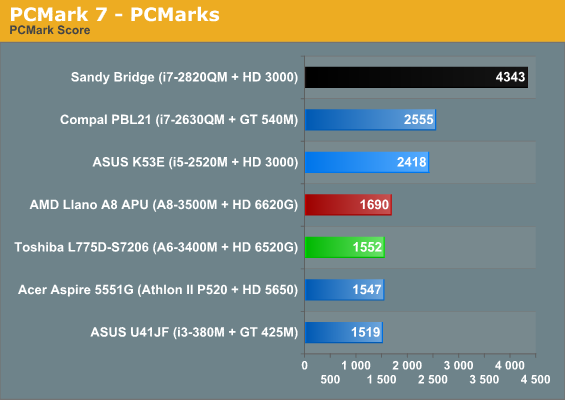
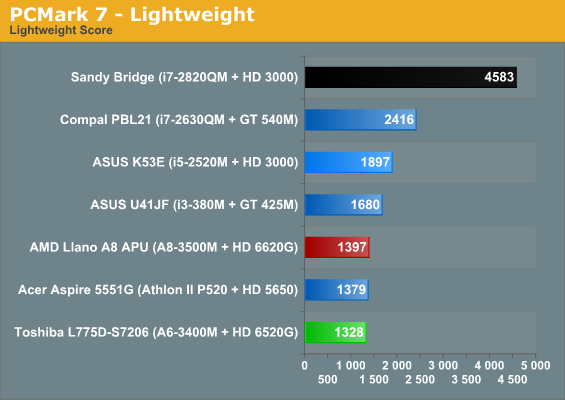
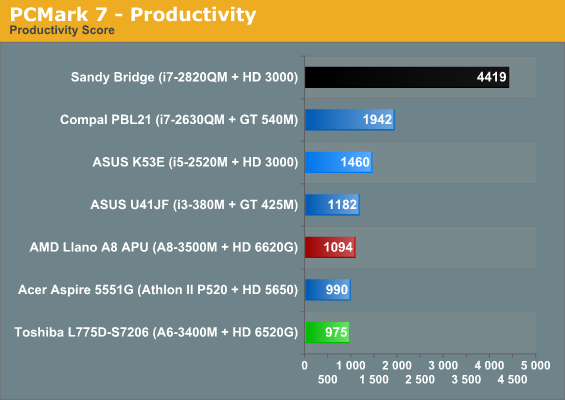
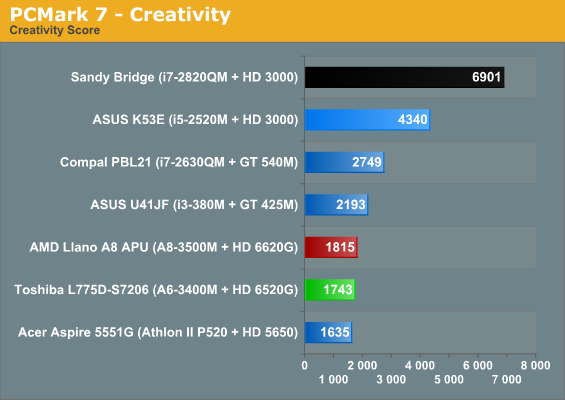
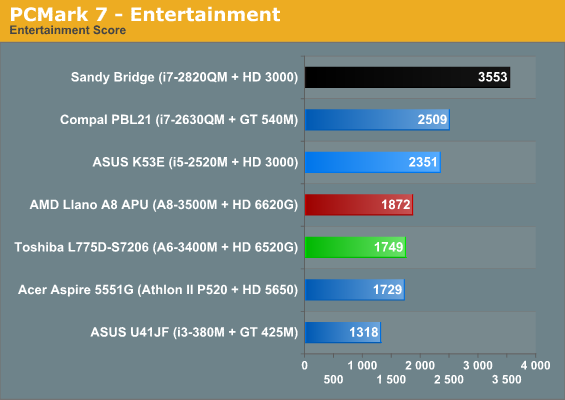

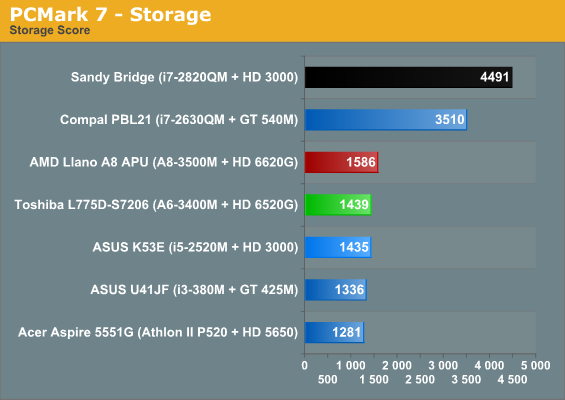
You can see in PCMark 7 that Sandy Bridge pretty much dusts the A6-3400M (noting that the quad-core Sandy Bridge test systems do benefit from SSDs), and it basically trades blows with Arrandale. The dual-core i5-2520M with an HDD is in the ASUS K53E, and outside of the storage test it also pummels Llano. What's particularly interesting, though, is that the A6-3400M is barely slower than the A8-3500M, at least in these synthetic tests. That makes sense: only 100MHz separates the two processors, but at least as far as the CPU goes you can make that sacrifice fairly comfortably since the A8 is much more rarefied in the wild than the A6. The Athlon II P520, meanwhile, boasts two cores at a nominal 2.3GHz and trades blows with the new Llano chips.

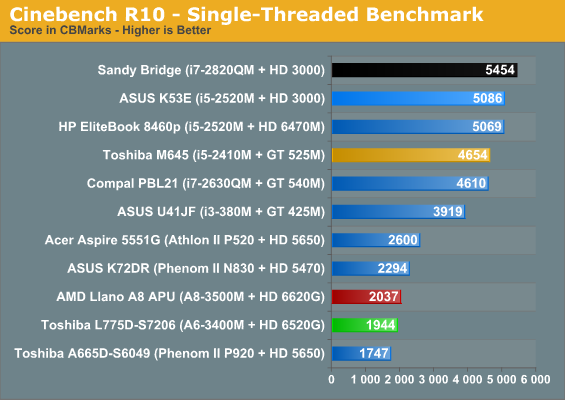
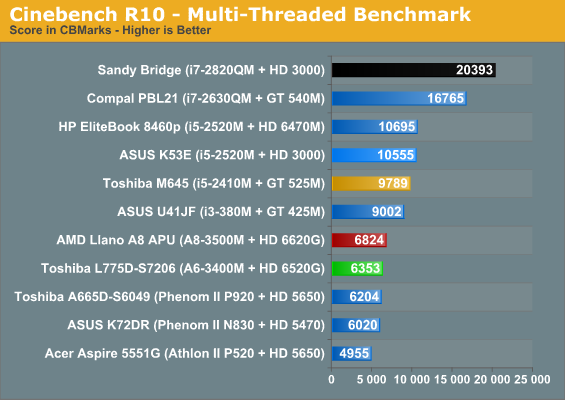
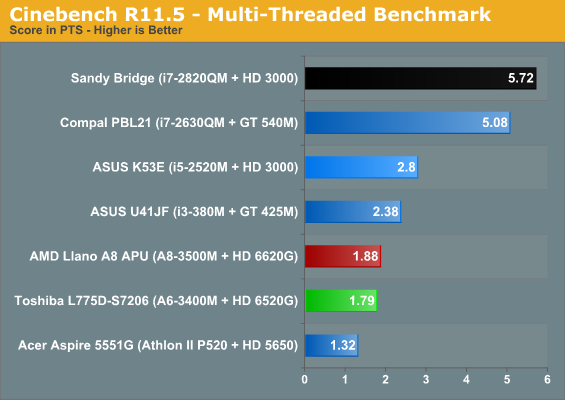
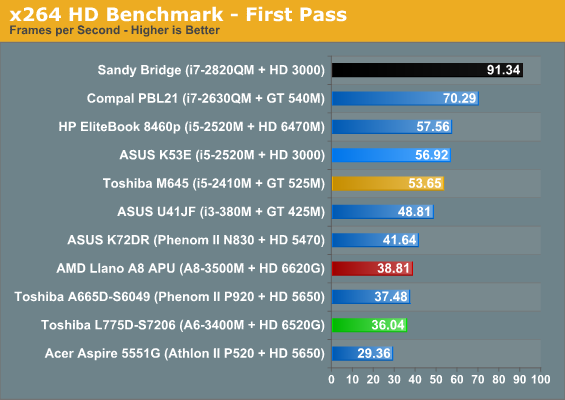
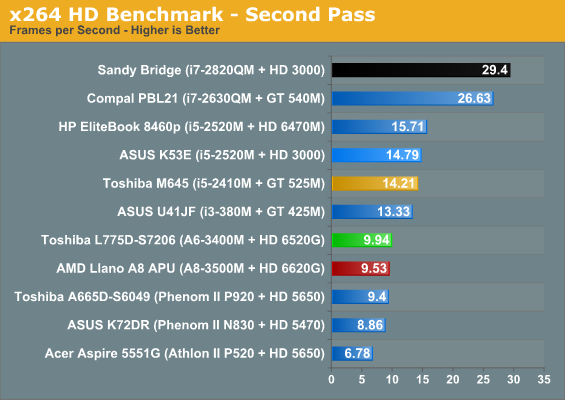
There's an awful lot to digest here. First, two of Intel's Hyper-Threaded cores running at a high clock speed basically run roughshod over four slow Stars cores: no surprsies there. But the Phenom II P920 in the Toshiba A665D-S6049 is a 1.5GHz quad core with 512KB of L2 cache per core instead of 1MB as in Llano, though the cores are otherwise almost identical. In most cases the AMD chips bunch together while the Intel chips gum up the top of the chart. The takeaway is brutal, though: Trinity, with its Bulldozer cores instead of Stars cores, can't get here fast enough. The i7-2820QM in our Sandy Bridge testbed is nearly three times faster than Llano, and the i5-2520M is about 60% faster on average.


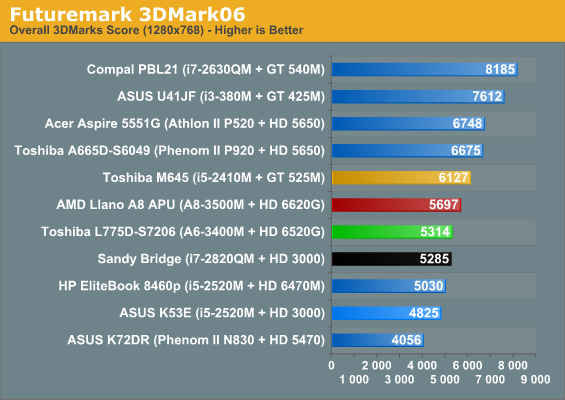
Things brighten up a bit when we get to 3DMark, where Llano's modified Redwood GPU core is able to hang fairly well with discrete-class GPUs. The A6-3400M may be closer to the bottom of the charts in each case, but it's still producing impressive performance compared to the string of dedicated graphics parts. It's easy to understand why AMD's PR splits hairs about calling Llano's graphics core an IGP and prefer to call it an "iGPU" or Fusion GPU, because while it's an IGP in the strictest sense, it doesn't necessarily deserve the negative connotations that have stigmatized the term as a result of Intel's pre-Sandy Bridge integrated graphics parts. Also worth pointing out in case you missed it is the lack of 3DMark11 results for any of the Intel IGPs; as a test that requires DX11, even Sandy Bridge can't run it without a dedicated GPU.










74 Comments
View All Comments
alxnet - Friday, August 12, 2011 - link
There's a number of 30% off or $300 off coupons floating around which gets you a substantial discount off a minimum $1000 custom laptop purchase from HP. Just google HP-30%-Coupon. Got my 9cell dv6z with an A8-3500 and a 1920x1080 screen for under $800. I've got a OEM Vertex 3 240GB which I got for less than $400 after rebate. Combined, it's one hell-uv-a laptop. Eight hours of runtime on average and it boots so quick I don't even bother putting it into sleep mode.JarredWalton - Friday, August 12, 2011 - link
Yeah, that's pretty slick. The SSD is of course a huge upgrade, but even without it, $800 for that sort of setup is far better than most $800 laptops you normally find. Since I'm not usually in the market for buying laptops, I don't scour around for coupons much. Maybe we need a guy dedicated to doing that and making little Pipeline posts? :-)Novaguy - Saturday, August 13, 2011 - link
My HP A8-3530MX system was $820 pre-tax/shipping using one of the 30% coupon, like alxnet mentioned. Base configuration price was $50 at the time (I should demand a price correction) but that works out to a $35 difference once you factor in the coupon. Not worth the aggravation of spending a couple hours on the phone with customer service.If I had to do it again, I might have aimed the processor lower (an A8-3510MX, probably) and maybe skipped the 6750M (maybe, it's kind of fun to have it just to see if it ever works).
I wouldn't skip the 1080p, though. It's my must buy upgrade, especially since the HP comes with blue-ray and one of things I use the laptop for is a portable DVD/blue ray player for when I travel. One negative - just like the toshiba here, HP has glossy plastic crap on the bezel. Why?
Also, I think that the 30% coupon only kicks in at the 999.00 base price, so when you get close, there is an incentive to get over it.
Shadowmaster625 - Friday, August 12, 2011 - link
If it runs cool then it should be overclocked. If it cannot be overclocked then it is useless. Again, the benchmark results seem to indicate that the chip only turbos up to 1.8GHz. Clearly the turbo is not functioning as it should.JarredWalton - Friday, August 12, 2011 - link
I'd say the Turbo is functioning exactly as expected. 2.3GHz is the max it can hit, but just like Intel I'm guessing you mostly won't get max -- maybe max minus a bin or two. Then again, with a 17.3" chassis the CPU ought to have more than enough cooling to be able to run faster. Personally, though, I don't believe in overclocking laptops at all. They may work fine for six months, or even two years, but most laptops already start to run pretty toasty when you start running games or other CPU/GPU intensive apps. I never find laptops to be so slow that I'd worry about a 10% overclock, and 33% usually pushes too far (outside of CULV, where that just made a CULV into a slightly lower clocked Core 2).DudleyUC - Friday, August 12, 2011 - link
I know companies like things in sets of 3, but I'm not sure there's a lot of need for the A6. The A4 gives you 2 cores at a higher clock (1.9 GHz) translating into better performance on single threaded CPU applications. It also gives you a faster clock (444 MHz) but on fewer shaders, yielding only slightly lower graphics performance.If you need 4 cores, it's not that much extra money for an A8 that gives you slightly better CPU performance than the A6 and substantially improved graphics performance.
So what niche does the A6 fill? Does the lower clocked GPU improve battery life? Is this just a marketing tactic (appealing to customers who don't want buy the cheapest option or the most expensive option)?
silverblue - Friday, August 12, 2011 - link
I think I can agree on this one. A proper (read: not with disabled cores) dual core Llano would result in less power usage and lower temperatures, so they could easily afford to throw out a much higher clocked variant. The productivity scores wouldn't suffer (they might actually be an improvement) as long as the Turbo Core implementation isn't significantly reduced.Having said that, I still can't help but wonder what a different cache implementation would achieve - unified L2 isn't an AMD thing so we can rule that out, but some L3 cache, perhaps? We've also learned that fast, low latency RAM is a big help for APU performance, and with the relative proximity in terms of pricing, the only thing you'd need to worry about with faster RAM would be the power usage... but again, if we're going dual core, that's nicely offset provided you don't go completely mad with the CPU clock. Manufacturers also have to remember that, with a discrete-level card, we can't have anaemic batteries on these machines, something we saw all-too-often with Phenom II laptops, so it's good to see some common sense with some Llano implementations. Regardless, look at how well they've gotten the power consumption down from 45nm to 32nm.
Llano is certainly niche, but some people will find value in the principle of a good enough CPU for most tasks paired with a decent GPU. Of course, for those with more money, it won't be as attractive, but not everyone is in that position (especially nowadays).
Dustin Sklavos - Friday, August 12, 2011 - link
It's been my experience looking at the differences between the Athlon II X4 and corresponding Phenom II X4 that the L3 cache doesn't actually have a major impact on performance, maybe 10% at most. The problem is that the Stars core just sucks. :|Also, Llano's memory controller is actually ridiculously efficient for the GPU. DDR3-1600 may help but I don't know how much and I'm not sure it's worth it in a notebook.
silverblue - Saturday, August 13, 2011 - link
Would you say that Llano's revised Stars cores are close in performance to those in Phenom II thanks to the extra L2 and the architectural tweaks?Additionally, one thing people have to remember about Llano is that it won't have a DDR2 memory controller taking up space, so that's good for reducing cost.
You're probably right as regards the memory controller. The laptop version of Llano has a much lower clocked GPU than is present on the desktop so that would reduce the need for faster RAM, but it'd be nice to see the effect.
Jawadali - Friday, August 12, 2011 - link
The article did point this out, but I just want to reiterate that similar versions of this laptop are often on sale. I have noticed that Staples' version goes on sale for $500 quite often (like it is now):http://www.staples.com/Toshiba-Satellite-L775D-S72...
I think I even saw it for ~$450 at one point. Compared to the one linked at Office Depot, I think the main differences are that is has a 500GB drive (instead of a 640GB), and does not have Blu-Ray. It also doesn't seem to have bluetooth.
I'd say it's a pretty decent general-purpose DTR in this price range.